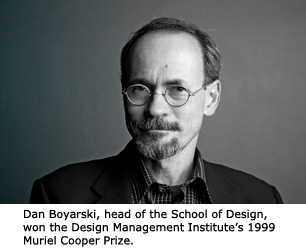Dan Boyarski, head of the School of Design at Carnegie Mellon, explores novel ways to communicate through effective design. The winner of the Design Management Institute’s 1999 Muriel Cooper prize also lectures and consults on interaction design issues. Dan recently shared his vision of where design is headed.
Carnegie Mellon does everything in a distinctive way. How would you describe Carnegie Mellon’s unique approach to design?

The School of Design believes in learning by doing. We believe in a human-centered design process, and in the value design brings to a range of human activities and how it affects people’s lives. These two sentences capture our guiding philosophy. We tell our freshmen, right from the start, that if we design for people, we need to understand who they are (the audience, the user) as an important precursor to developing the appropriate form. The resulting artifact—be it physical or virtual, an environment or a service—should meet real human needs and solve a problem.
Designed artifacts are all around us—digital communication devices, posters, books, Web sites, furniture, packaging, exhibitions, identity systems, various services and even organizational structures. They each fill a human need for communication, information, learning, or entertainment. For us, appropriate and handsome form goes hand-in-hand with thoughtful problem solving. Ultimately, we strive for a balance of thinking and making, of theory and practice.
Our approach to design education is distinctive because so many design programs still stress the visual and the aesthetic, with little or no consideration for the end user or the context for use.
It’s often said that the Macintosh computer revolutionized design. Is there another revolution coming? What do you think may generate it?
The personal computer helped revolutionize some of the practical aspects of designing, but the design process itself has changed little. What has changed, though, is a greater emphasis on better understanding the people we’re designing for, along with a more collaborative nature to the design process.
The next revolution to affect the practice of design is the dematerialization of design artifacts. Physical and digital products are as likely to be part of a larger system of services, as they are to be stand-alone deliverables. Therefore, understanding the design of systems, services, organizations and infrastructures is as critical as understanding human behavior and appropriate form. This is the challenge we face in design education today and it happens to be the same challenge faced by design professionals around the world. The solution is a broader definition of design and more collaborative methods of working—not a hard sell at Carnegie Mellon. In fact, the School of Design already collaborates with colleagues in English, the Human-Computer Interaction Institute, Robotics, Mechanical Engineering and the Tepper School of Business.
Is it possible to judge design (or any visual product) on issues other than aesthetics?
An often-used quote describes a well-designed product as being “useful, useable and desirable.” Most people and most design competitions focus on the formal and aesthetic aspects of a product, which certainly cannot be dismissed. People do respond, often with strong emotions, to beautifully designed and crafted products (physical and virtual) that answer a need with ease and comfort, as well as elegance. In short, the best product design is one that balances all three aspects in a seemingly effortless and transparent manner.
Related Links:
School of Design
Dan Boyarski



